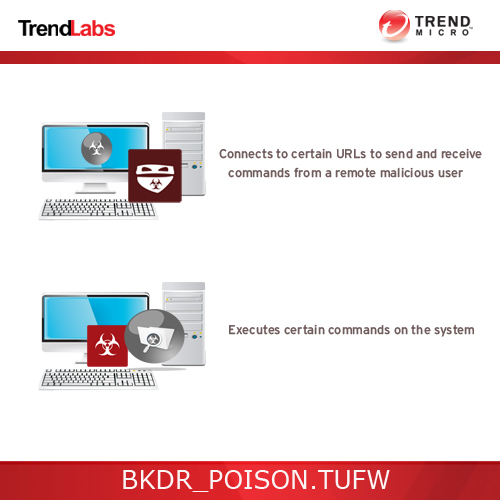BKDR_POISON.TUFW
Backdoor.Darkmoon (Symantec)
Windows


Threat Type: Backdoor
Destructiveness: No
Encrypted: No
In the wild: Yes
OVERVIEW
This malware is related to the campaign that targeted TV and government-related websites in Hong Kong and Taiwan. In the said campaign, attackers used Flash exploits that emerged from the Hacking Team leak to deliver this PoisonIvy variant.
To get a one-glance comprehensive view of the behavior of this Backdoor, refer to the Threat Diagram shown below.

This backdoor may be downloaded by other malware/grayware from remote sites.
It executes commands from a remote malicious user, effectively compromising the affected system.
TECHNICAL DETAILS
Arrival Details
This backdoor may be downloaded by the following malware/grayware from remote sites:
Backdoor Routine
This backdoor executes the following commands from a remote malicious user:
- Send system information (Lan IP, Wan IP, Computer name, Username, Account Type, OS)
- Send hardware information (CPU speed, Memory)
- Manage Files (Search, Download, Upload, Execute, Rename, Delete)
- Manage Registries (Search, Modify, Delete, Rename, Create)
- Manage Processes (View, Kill, Suspend, Unload Module)
- Manage Services (View, Start, Stop, Edit, Install, Uninstall)
- Manage Devices (View, Enable, Disable, Remove)
- Manage Windows
- Relay server
- View,copy and uninstall applications
- View active ports
- Perform a shell command
- Download and inject remote codes to legitimate processes
- Log keystrokes and active window
- Capture screenshots
- View webcam activity
- Listen to microphone audio
- Update, Uninstall, Restart the malware
- Retrieve cached passwords and hashes
It connects to the following URL(s) to send and receive commands from a remote malicious user:
- win7.{BLOCKED}z.info:443
SOLUTION
Step 1
Before doing any scans, Windows XP, Windows Vista, and Windows 7 users must disable System Restore to allow full scanning of their computers.
Step 2
Remove the malware/grayware file that dropped/downloaded BKDR_POISON.TUFW. (Note: Please skip this step if the threat(s) listed below have already been removed.)
Step 3
Identify and terminate files detected as BKDR_POISON.TUFW
- Windows Task Manager may not display all running processes. In this case, please use a third-party process viewer, preferably Process Explorer, to terminate the malware/grayware/spyware file. You may download the said tool here.
- If the detected file is displayed in either Windows Task Manager or Process Explorer but you cannot delete it, restart your computer in safe mode. To do this, refer to this link for the complete steps.
- If the detected file is not displayed in either Windows Task Manager or Process Explorer, continue doing the next steps.
Step 4
Scan your computer with your Trend Micro product to delete files detected as BKDR_POISON.TUFW. If the detected files have already been cleaned, deleted, or quarantined by your Trend Micro product, no further step is required. You may opt to simply delete the quarantined files. Please check this Knowledge Base page for more information.
Did this description help? Tell us how we did.

